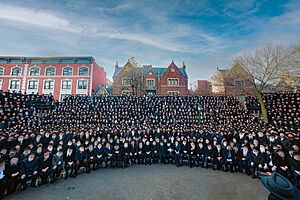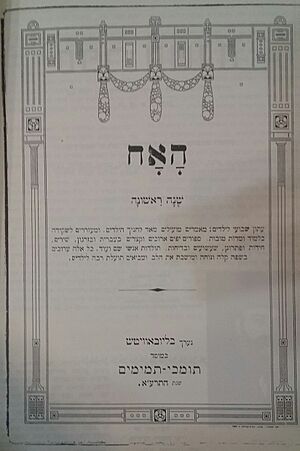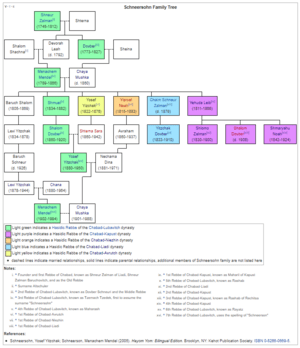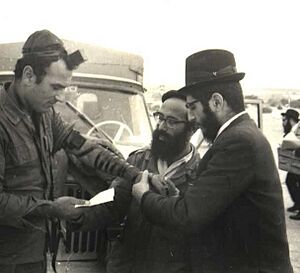Chabad facts for kids
|
חב״ד
|
|

Group picture of Chabad Shluchim (emissaries) in Crown Heights, Brooklyn
|
|
| Formation | 1775 |
|---|---|
| Founder | Shneur Zalman of Liadi |
| Founded at | Liozno, Russian Empire |
| Type |
|
| Headquarters | 770 Eastern Parkway, Brooklyn, New York City, U.S. |
|
Region served
|
Worldwide |
|
Membership (2018)
|
90,000–95,000 |
|
Key people
|
Menachem Mendel Schneerson |
| Secessions | Strashelye, Kopust, Liadi, Niezhin, Avrutch, Malachim |
| Affiliations | Hasidic Judaism |
Chabad, also known as Lubavitch or Habad, is a movement within Hasidic Judaism. It is one of the most well-known Jewish religious groups in the world. Chabad is part of Orthodox Judaism. Unlike many other traditional Jewish groups, Chabad focuses on reaching out to all Jews, no matter how religious they are.
The movement was founded in 1775 by Rabbi Shneur Zalman of Liadi in the town of Liozno, which was then part of the Russian Empire. The name "Chabad" (חב״ד) is an acronym for three Hebrew words: Chokmah (Wisdom), Binah (Understanding), and Da'at (Knowledge). These ideas are central to the group's philosophy. The name "Lubavitch" comes from a town in Russia where the movement's leaders lived for over 100 years.
In the 1940s, the sixth leader of Chabad, Rabbi Yosef Yitzchak Schneersohn, moved the movement's headquarters to Brooklyn, New York. His successor, Rabbi Menachem Mendel Schneerson, led the movement from 1951 to 1994. He helped it grow into a global network of centers that provide religious, social, and educational support to Jewish people everywhere.
Today, there are thousands of Chabad centers around the world. It is estimated that up to one million Jews participate in Chabad services or activities each year.
Contents
History of Chabad
The Chabad movement was started in 1775 by Rabbi Shneur Zalman of Liadi. He was a student of Rabbi Dov Ber of Mezeritch, who was the successor to the founder of Hasidism, Rabbi Israel Baal Shem Tov.
In 1813, the second leader, Rabbi Dovber Schneuri, moved the movement to the town of Lyubavichi in Russia. The movement was based there for a century. In 1915, the fifth leader, Rabbi Sholom Dovber Schneersohn, moved the center to Rostov-on-Don.
Later, the sixth leader, Rabbi Yosef Yitzchak Schneersohn, moved the movement to Poland. When World War II began, he escaped to the United States. Since 1940, Chabad's headquarters has been in the Crown Heights neighborhood of Brooklyn, New York.
Challenges in Russia
The Chabad movement faced many difficulties in Russia. The government, first under the Czar and later under the Bolsheviks, was often against the movement. Most of the Chabad leaders, called Rebbes, were imprisoned by these governments. Many Chabad followers also faced harsh treatment.
During World War II, many Chabad Hasidim moved to cities like Samarkand and Tashkent in Central Asia. They created small communities there while trying to leave Soviet Russia. Even after the movement's center moved to the U.S., Chabad secretly helped Jews in the Soviet Union. Since the dissolution of the Soviet Union in 1991, this persecution has stopped.
Chabad's Leaders
The Chabad movement has been led by a series of leaders known as Rebbes. There have been seven Rebbes in the main Chabad-Lubavitch branch.
- Rabbi Shneur Zalman of Liadi (1745–1812): He founded the Chabad movement. He wrote the Tanya, a central book of Chabad philosophy that is studied daily by followers. He is often called the "Alter Rebbe" (Old Rebbe).
- Rabbi Dovber Schneuri (1773–1827): The son of the founder, he led the movement from the town of Lubavitch. He expanded on his father's teachings. He is known as the "Mitteler Rebbe" (Middle Rebbe).
- Rabbi Menachem Mendel Schneersohn (1789–1866): A grandson of the founder, he was a great scholar of Jewish law. He is known as the "Tzemach Tzedek," after the title of one of his books.
- Rabbi Shmuel Schneersohn (1834–1882): The youngest son of the Tzemach Tzedek. He is known as the "Maharash."
- Rabbi Shalom Dovber Schneersohn (1860–1920): He founded the Chabad yeshiva (a school for Jewish studies) called Tomchei Temimim. He is known as the "Rashab."
- Rabbi Yosef Yitzchak Schneersohn (1880–1950): The only son of the Rashab. He moved the movement to the United States and set up many of Chabad's main organizations. He is called the "Rayatz" or the "Frierdiker Rebbe" (Previous Rebbe).
- Rabbi Menachem Mendel Schneerson (1902–1994): The son-in-law of the previous Rebbe. He transformed Chabad into a global movement by sending thousands of emissaries (shluchim) around the world. He is often called "the Lubavitcher Rebbe" or simply "the Rebbe." He did not appoint a successor.
Chabad's Philosophy
Chabad philosophy is based on the teachings of the founders of Hasidism. It uses Jewish mystical texts, like the Zohar and the teachings of Rabbi Isaac Luria, to explain religious ideas. A core idea is making the world a "dwelling place for God" by doing good deeds.
The book Tanya, written by the founder Rabbi Shneur Zalman, is the foundation of Chabad thought. It explains that a person has two inclinations, one for good and one for bad, and that the mind should rule the heart. This means using intellect and understanding to guide one's feelings and actions toward serving God.
The name Chabad comes from the Hebrew words for three intellectual powers:
- Chokmah (Wisdom): The first spark of an idea.
- Binah (Understanding): Developing the idea and understanding it fully.
- Da'at (Knowledge): Applying the idea to one's life.
By using these three powers, a person can develop a deep love and awe of God, which leads them to follow the Jewish commandments.
The Chabad Community
A follower of Chabad is called a Chabad Hasid or a Lubavitcher. Chabad communities exist all over the world, with large centers in Crown Heights, Brooklyn, and Kfar Chabad, Israel. The movement has attracted many Sephardic Jews as well as Ashkenazi Jews.
In 2018, it was estimated that there were about 90,000 to 95,000 Chabad followers worldwide. However, many more Jews who are not official followers participate in Chabad activities.

Chabad Organizations and Activities
Chabad is known for its many organizations and outreach programs. The goal of these activities is to help Jews connect with their heritage.
Chabad Houses
A Chabad House is a Jewish community center that offers educational classes, prayer services, holiday celebrations, and support for local Jews. They are run by a Chabad emissary (shaliach) and his wife. Chabad Houses are designed to be welcoming to all Jews, regardless of their level of observance. The first Chabad House was opened at the UCLA campus.
Outreach Activities
Rabbi Menachem Mendel Schneerson encouraged his followers to reach out to fellow Jews and help them learn more about Judaism. This led to many outreach efforts, including:
- Mitzvah Campaigns: Chabad encourages Jews to perform specific commandments (mitzvot), such as lighting Shabbat candles, putting on tefillin (phylacteries), and giving to charity.
- Mitzvah Tanks: These are vehicles, often RVs, that act as mobile Chabad centers. They can be found in cities around the world, offering a place for people to do a mitzvah or ask questions about Judaism.
- Campus Outreach: Chabad has a strong presence on college campuses, providing a "home away from home" for Jewish students.
- CTeen: This is Chabad's teen network, which offers social and educational programs for Jewish teenagers around the world.
Publishing
Chabad's publishing house, Kehot Publication Society, is one of the largest publishers of Jewish books in the world. It translates and prints Jewish texts in many languages, making them accessible to a wide audience. Chabad also runs one of the largest faith-based websites, Chabad.org, which offers a vast amount of information on Judaism.
Summer Camps
Chabad runs the Gan Israel network of summer camps, which is the largest network of Jewish camps in the world. These camps provide a fun and educational Jewish experience for children from all backgrounds.
See also
 In Spanish: Jabad-Lubavitch para niños
In Spanish: Jabad-Lubavitch para niños






